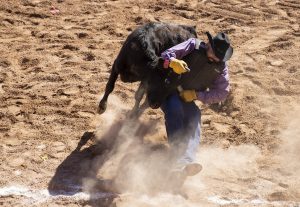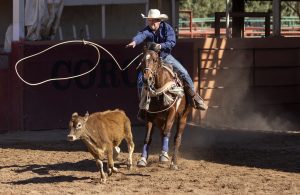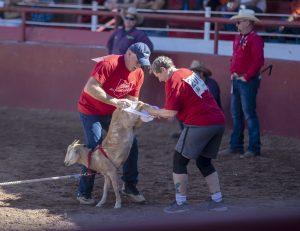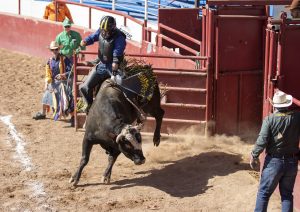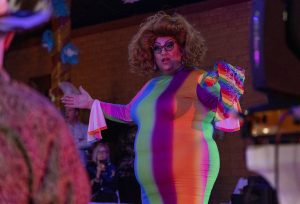- Slug: Sports-Gay Rodeo, 870 words.
- 5 photo available
By Alyssa Gomez
Cronkite News
LAVEEN – In many ways it resembled a typical rodeo, with events including team roping and bull riding.
It was the goat dressing, steer decorating and “Wild Drag Race” that suggested this was something unique.
The recent Arizona Gay Rodeo at the Corona Ranch and Rodeo Grounds highlighted an event and a community determined to provide a safe space for anyone interested in participating in western activities.
”We have to keep the country and western atmosphere alive,” said founding member John Beck, who has competed in all 13 events in his near 40-year tenure. said. “It keeps kids interested, keeps them off drugs. keeps their brain straight and keeps them athletically in shape because a lot of school systems don’t have classes or anything.”
After Prescott established what it bills as “The World’s Oldest Rodeo” on July 4, 1888, the sport of rodeo has spread to communities around the world.
And that includes the LGBTQ+ community.
The Arizona Gay Rodeo Association started in 1984 when Arizona became the fifth state to host a gay rodeo. Arizona joined the International Gay Rodeo Association in 1985 along with California, Colorado and Texas.
Originally the Arizona event started as a fundraiser but has now evolved into a larger program that takes place over two days.
Arena Director and Chute Coordinator Tim Smith joined the gay rodeo through the Texas Gay Rodeo Association, after a former partner, who was a contestant and rodeo announcer, introduced him in 1987. Smith competed in not only the actual rodeo events, but in the drag aspects and became Miss International Gay Rodeo in 1994 as “Miss Tessy.” Smith believes the togetherness of the gay rodeo has provided a welcoming environment and has allowed him to find the people that accept him.
“The camaraderie is different,” Smith said. “One of the biggest differences is that it’s open to men and women. Anybody that comes into this they go, ‘Wow, it’s actually really friendly.’ I’ve known some of my best friends for over 30 years that actually came from the association.”
Smith’s dedication to the community led him into being inducted into the International Gay Rodeo Hall of Fame in 2019.
“It was one of the biggest honors,” Smith said as he held his Hall of Fame belt buckle.
One of the most important aspects of the Gay Rodeo is community. Not only does the event harbor a family friendly and safe experience for those in the LGBTQ+ community, but it also works hard to give back to the communities that help support it.
“I believe that community engagement is how the IGRA and AGRA brings in different nonprofits throughout the local communities,” said Kody Misinco, long-time fan of the Arizona Gay Rodeo.
While the Arizona Gay Rodeo heavily relies on the community it serves, it is not exclusive.
David Limon has been a cowboy for a year and half and competed in the gay rodeo circuit for the first time this year in both steer and bull riding. Limon served six years in the Marine Corps and was drawn to rough stock as a way to adjust to normal life.
There was no holding back for Limon, as he entered the dangerous sport with a passion for patriotism and a “go big or go home” mentality
“‘When I got out of the Marine Corps, it was kind of hard to transition back to the normal world,” Limon said. “So I had to find something that I was wanting to be passionate about because I didn’t want to go back to the military, because if you go back you basically failed to succeed outside the military. So one day a video about bull riding pulled up on YouTube … and ever since then I’ve been hooked.”
Limon is not part of the LGBTQ+ community but believes that could make his participation in the gay rodeo even more impactful.
“At first it was just for laughs and giggles because I’m not gay,” Limon said. “But I started reading more into the history of the gay rodeo and it’s an actual legit circuit. I’m trying to break the barriers and show gay cowboys and straight cowboys, we all get along and compete in the same arena. Those bulls don’t know that it’s a gay rodeo.”
While Limon was able to embrace the community and receive the same welcoming attitude back, not everyone in his circle shared the same feelings.
“I have friends that didn’t want to come because it’s a gay rodeo, but I guarantee you they wouldn’t survive,” Limon said about the competition.
Limon plans to continue competing until he physically can’t. At 25, he has had two knee injuries and multiple areas of pain including head, ribs and shoulder. Limon shares the beliefs of other cowboys and feels “when you get on your final bull, you’ll know that’s your final bull.”
Regardless of how long he competes, he has been able to continue the legacy of finding yourself in a community that the Arizona Gay Rodeo has fostered.
“It’s all inclusive, there’s no hate,” Misinco said. “it allows people that could be trans that could identify as gay, bi, and so on to to be here and actually have physical representation.”
